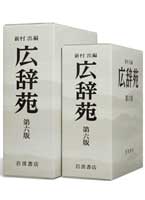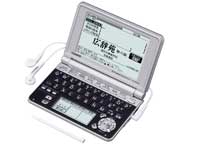|
DEFINING THE MODERN AGE
Leading Dictionary Undergoes First Major Revision in 10 Years
(February 29, 2008)
|
|
When you come across a word you do not know or you want basic information about something, dictionaries are there to help you out, serving as a readily accessible treasury of knowledge. Dictionaries in Japan are evolving in leaps and bounds. Kojien, Japan's best known dictionary, has recently undergone its first major revision in a decade, while a revolutionary dictionary of kanji characters has been an unlikely hit. Meanwhile, people are increasingly turning from print volumes to electronic dictionaries the size of portable game consoles, some of which contain as many as 100 volumes' worth of information. Ten Thousand New Entries Iwanami Shoten, a Japanese publishing firm, recently issued a major revision of Kojien, the most prominent kokugo dictionary, for the first time in 10 years. Originally published in 1955 and now in its sixth edition, some 11 million copies of Kojien have been sold overall. One of the key features of the latest revision - the first since 1998 - is the addition of many neologisms used by young people and words of foreign origin. There has been strong demand for definitions of new words that often puzzle older people, such as NEET (referring to young people "not in education, employment, or training"), kaomoji (emoticons), and love-love (lovey-dovey). With the inclusion of terms like these, the number of entries has grown by 10,000 to 240,000. New Kanji Dictionary with Examples from Literature Aimed at helping users to read and write contemporary Japanese, the Shincho Nihongo Kanji Jiten contains example sentences quoted from literary works by such Japanese authors as Natsume Soseki, Mori Ogai, and Akagawa Jiro. It includes 47,000 Japanese words made up of combinations of kanji. Among them are kosumosu (cosmos flower, written with two kanji characters meaning "fall" and "cherry") and yukata (cotton kimono, written with characters for "bathe" and "clothes"). The dictionary is also notable for its having been compiled by nonscholars. A veteran proofreader with the publisher almost single-handedly put the volume together over a period of 10 years. A Hundred Dictionaries in Your Hand Compact, lightweight, and easy to search, electronic dictionaries contain the digitized content of a wide variety of dictionaries and books. References range from language dictionaries both Japanese and foreign - including Kojien - to dictionaries of information technology, medicine, and other fields; encyclopedias; and books on English conversation, cooking, and other subjects. Models containing 10 to 20 volumes' worth of information are common, and some comprise as much as 100 volumes' worth. The majority of electronic dictionaries fall in the price range of ¥10,000 to ¥50,000 (about $90 to $450 at ¥110 to the dollar) - a bargain considering that print volumes cost from several thousand to ten thousand yen each. Some electronic dictionaries also contain audio files, which are useful for practicing foreign language conversation. In addition to the keyboard, a growing number of dictionaries allow users to input characters with a stylus. This is convenient when looking up kanji that one does not know how to read. Electronic dictionaries are undergoing technological innovation at lightning speed, and every year sees the appearance of new functions. |
Copyright (C)2008 Web Japan. Edited by Japan Echo Inc. based on domestic Japanese news sources. Articles presented here are offered for reference purposes and do not necessarily represent the policy or views of the Japanese Government.


